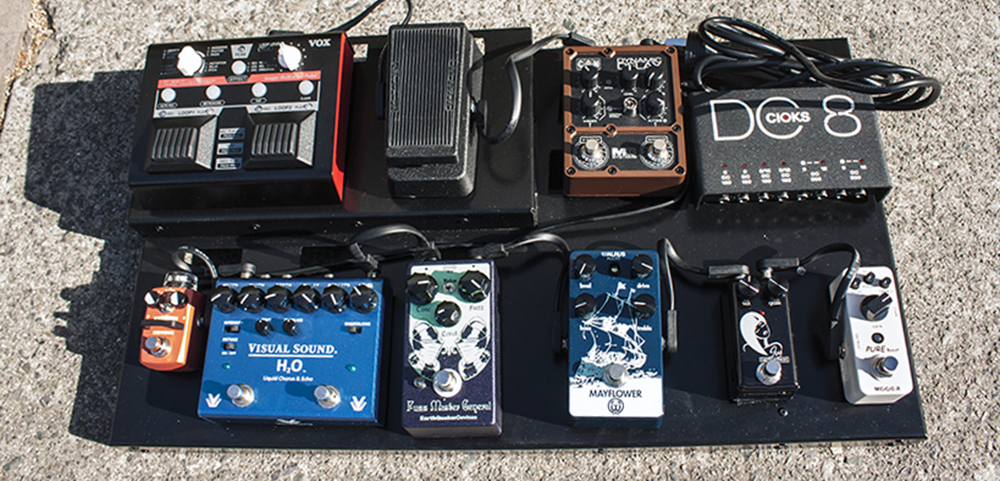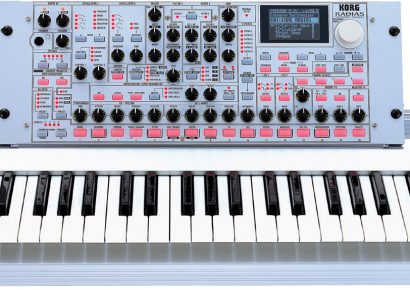However, there is a school of thought that says that fewer pedals on a pedalboard will lead to a more pure sound and better playing. But do you really want to rock up to your experimental noise rock band rehearsal with one fuzz pedal? Probably not. Obviously different situations will require different setups, and below we’ve looked at some of the advantages of both small and large pedalboards.
Small Pedalboards
For many the main advantage of a small board is that it is easy to transport. A single, small board in a bag or case will be a lot easier to bring to a gig and set up than a three board behemoth, which will make loading in and out of gigs, rehearsals and recordings a breeze.
A small board will be easier to play on stage; tap dancing between pedals and balancing on one leg while trying to reach the delay at the end of the board will become a thing of the past. Another advantage on stage is that troubleshooting is easier with a smaller board, as there are simply less things that could be broken.
From a more tonally conscious perspective, the argument for fewer pedals is that it keeps the signal from the guitar to the amp cleaner and making it sound better. There is even a small-but-vocal camp that is vehemently opposed to pedals, holding the belief that a guitar plugged straight into an amp is the best way to go. A barebones board could be the tonal saviour you’re after.
Finally, and perhaps most importantly, a smaller pedalboard will put the focus back on your playing. Without 50 different pedals affecting your sound, there’s less to hide behind. Although this sounds daunting, it is for the best. Most people at a show would much prefer to hear someone nailing everything they’re trying to play with a stock-standard tone, rather than fudging their songs through a super cool, heavily modulated wall of sound. If you’ve been behind that wall for too long, you might want to show your face again…
Large Pedalboards
Although I’ve kind of bashed big boards above, they definitely have a place in the setup of many guitarists in a range of different situations.
A large pedalboard will give the player access to heaps more different sounds, making experimenting and finding new tones easier. Hopefully you’ll also be able to find some original sounds. This can be handy in the studio to get the player out of a creative rut, as well as onstage, where they have the option to fulfil an idea that comes to them in a moment of inspiration mid-song or mid-set.
The ability to choose from a wide range of pedals also comes in handy for a guitarist that doesn’t stick exclusively to one genre. The pedals that work well for a prog rock-type song might not be as useful for the punk-pop number that the band plays later in the set, and so having the wide variety becomes necessary.
Another reason for a large pedalboard is to replicate the sounds that were made in the studio live. Running the guitar through different plugins or DAWs isn’t always possible on stage, especially for people who like to avoid computers in their live setup, therefore replicating the sound of the album has to be done with pedals. John Frusciante during the Red Hot Chili Peppers’ Stadium Arcadium era is a good example of this. He couldn’t take all the modular gear that he was using in the studio out on tour with him, so he built a two-storey pedalboard. This had a follow-on effect for current guitarist Josh Klinghoffer (who replaced Frusciante), who tours with three massive pedalboards.
Looking again to the professional arena, Kevin Parker of Tame Impala has often cited the desire to make non-guitar sounds with a guitar as a reason for his extensive live setup. By using plenty of modulation pedals, you can disguise the sound of the guitar and almost give your band a different instrument to use. Large pedalboards allow the player to completely define the sound that they want, with greater control over the finer aspects of the sound.
In summation…
Regardless of which side of the debate you’re on, there is a general consensus that pedals should be used to complement good guitar playing, rather than mask bad playing. Both small and large pedalboards have their advantages and drawbacks, but the skill of the guitarist will always shine through either way. Now be a good guitarist and go and practise some scales.

